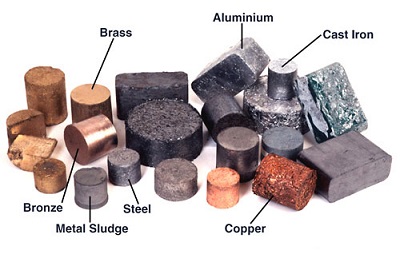|
Monday, 16 July 2018
 How to protect Metal Resources?
Mood:
How to protect Metal Resources?
Mood:
 a-ok
Topic: Metal Resources a-ok
Topic: Metal Resources
Metallic materials are an important material basis for the development of human society, and most metallic elements exist in minerals in the form of compounds in nature. As a result, millions of tons of metal are extracted from metal minerals each year for industrial and agricultural purposes, the largest of which is iron. 
The process of obtaining metal elements from metal minerals is called metal smelting. Different metal smelting methods are different, the more active the metal, the more difficult the smelting process. According to the metal activity sequence table, we can know that it is most difficult to smelt active metal potassium, calcium, sodium, magnesium, and aluminum. For these metals, electrolysis is used in the production in practice, and only when a metal compound is fused by electrolysis can a metal be obtained. The less active metals such as iron, molybdenum, tungsten, and copper are usually obtained by CO reductants and mineral reactions; mercury and silver metals are usually obtained by heating and decomposing their minerals; the most stable platinum and gold are found in nature in the form of a single substance, which can be obtained directly from the ore. This may explain why the history of human use of metals began in the Bronze Age, followed by the Iron Age, followed by aluminum products. However, the reserves of metal minerals are limited and cannot be recycled, so how to protect the metal resources has become an urgent problem. After analysis, we can solve the problem from the following aspects. First of all, control the centralized development of resources in the development process to avoid the waste of symbiotic metals due to limited development conditions. Secondly, it is important to do a good job in the use of metal corrosion prevention. It is reported that the world's annual corrosion of metal equipment and materials is equivalent to 20-40% of the annual output. Common anticorrosion methods include coating metal with plastic, painting, painting oil, enamel, plating more corrosion-resistant metals (such as copper, chrome, etc.), adding metal chromium and nickel to make stainless steel, etc. Finally, we should actively develop new materials to replace the original metal materials. Please visit http://www.samaterials.com for more information.
 How to protect Metal Resources?
Mood:
How to protect Metal Resources?
Mood:
 a-ok a-ok
Metallic materials are an important material basis for the development of human society, and most metallic elements exist in minerals in the form of compounds in nature. As a result, millions of tons of metal are extracted from metal minerals each year for industrial and agricultural purposes, the largest of which is iron. 
The process of obtaining metal elements from metal minerals is called metal smelting. Different metal smelting methods are different, the more active the metal, the more difficult the smelting process. According to the metal activity sequence table, we can know that it is most difficult to smelt active metal potassium, calcium, sodium, magnesium, and aluminum. For these metals, electrolysis is used in the production in practice, and only when a metal compound is fused by electrolysis can a metal be obtained. The less active metals such as iron, molybdenum, tungsten, and copper are usually obtained by CO reductants and mineral reactions; mercury and silver metals are usually obtained by heating and decomposing their minerals; the most stable platinum and gold are found in nature in the form of a single substance, which can be obtained directly from the ore. This may explain why the history of human use of metals began in the Bronze Age, followed by the Iron Age, followed by aluminum products. However, the reserves of metal minerals are limited and cannot be recycled, so how to protect the metal resources has become an urgent problem. After analysis, we can solve the problem from the following aspects. First of all, control the centralized development of resources in the development process to avoid the waste of symbiotic metals due to limited development conditions. Secondly, it is important to do a good job in the use of metal corrosion prevention. It is reported that the world's annual corrosion of metal equipment and materials is equivalent to 20-40% of the annual output. Common anticorrosion methods include coating metal with plastic, painting, painting oil, enamel, plating more corrosion-resistant metals (such as copper, chrome, etc.), adding metal chromium and nickel to make stainless steel, etc. Finally, we should actively develop new materials to replace the original metal materials. Please visit http://www.samaterials.com for more information.
 Why is the Back Cover of Zirconium Oxide Ceramic difficult to popularize at present?
Mood:
Why is the Back Cover of Zirconium Oxide Ceramic difficult to popularize at present?
Mood:
 a-ok
Topic: Back Cover of Phones a-ok
Topic: Back Cover of Phones
With the development of smartphones, more and more demands have been placed on mobile phone materials. The back cover of zirconium oxide ceramics is popular because of its excellent performance, but it is difficult to popularize because of its high cost and low production capacity. The following are some reasons why zirconia cell phone covers are difficult to be popularized at this stage. Zirconia ceramics have the highest cost in terms of cost, followed by metal, and glass is the cheapest. A piece of zirconium oxide back cover is expected to cost about $30, and a piece of 2.5-d glass costs about $4. In terms of production capacity, zirconia ceramics are currently subject to the production capacity restrictions of powders, resulting in the limited capacity of the back cover, which cannot meet the demand of hundreds of millions of mobile phones. 
The back cover of zirconia ceramics adopts precision ceramic processing technology, and its material production and processing technology are complicated, which usually consists of dozens of processes control and material control, mainly including upstream powder materials, mid-stream molding/sintering, and post-processing, and there are countless options at each stage. After sintering, the finishing grinding treatment can only improve the surface performance. In order to ensure the size and precision of finished products, the shrinkage and consistency of materials, raw porcelain and sintering should be considered, and repeated experiments and improvements should be made, the technical know-how presented in which constitutes a huge threshold for the manufacture of zirconia ceramic cover. Material process Doped and modified with rare earth elements on the basis of advanced nano-zirconium oxide powders, chemical adhesives and other materials are added to form a viscous solution with the organic solvent as a carrier. Sintering process The control of the temperature curve and the atmosphere is the key to product quality. In the post-sintering process, the finished porcelain is grinded and modified according to the different products to ensure the consistency of its performance and physical structure. Please visit http://www.samaterials.com for more information.
Tuesday, 10 July 2018
 What are the Excellent Properties of Tantalum Capacitors?
Mood:
What are the Excellent Properties of Tantalum Capacitors?
Mood:
 blue
Now Playing: Tantalum Capacitors
Topic: Tantalum Capacitors blue
Now Playing: Tantalum Capacitors
Topic: Tantalum Capacitors
Tantalum capacitors have many excellent properties and are widely used in military communications, aerospace, industrial control, film and television equipment, communication instruments and other industries.  Tantalum capacitors are a kind of electrolytic capacitors, and they use metal tantalum as a medium instead of electrolyte as common electrolytic capacitors. Tantalum capacitors do not need to be wrapped in aluminum-coated capacitors like ordinary electrolytic capacitors, and tantalum capacitors themselves have little inductance, which limits their capacity. The working medium of tantalum capacitor is a thin layer of tantalum peroxide film formed on the surface of tantalum metal, which is integrated with one end electrode of the capacitor and cannot exist alone. Therefore, tantalum capacitors have very high working electric field intensity in unit volume, and their electric capacity is especially large, so it is especially suitable for miniaturization. Tantalum capacitors have excellent performance. They are small capacitors with large capacity, which has few competitors in power filtering, ac bypass, and other applications. Tantalum electrolytic capacitors have the properties of storing electricity, charging and discharging, and are mainly used in filtering, energy storage and conversion, marked bypass, coupling and decoupling, and as the time constant components. Attention should be paid to its performance characteristics in the application, which include measures such as the working environment of the product and its heating temperature, as well as the use of reduced volume. Proper use will help to give full play to its functions; otherwise, it will affect the working life of the product. The tantalum capacitor has the function of repairing or isolating the defects in the oxide film, which enables the oxide film medium to be reinforced at any time and restored its due insulation capacity without continuous cumulative damage. This unique self-healing performance ensures its long life and reliability advantages. Please visit http://www.samaterials.com for more information.
Tuesday, 10 July 2018
 How far are we from the Space War?
Mood:
How far are we from the Space War?
Mood:
 blue
Topic: Space War blue
Topic: Space War
Warnings of an imminent space war have been ringing up in recent years. David Goldfein, the U.S. Air Force Chief, said that the space war between the superpowers could begin in a few years' time in February 2018, while space weapons are the No.1 weapon in Russia's hypothetical Third World War. The New Global Threat Assessment Report, released by the office of the director of National Intelligence, also warns of the growing possibility of space wars. 
Much of the pessimism about the space war has been driven by the sudden spurt of the world's great powers in space and the implicit militarisation of the latest space technology. The use of space for peaceful purposes is widely recognized around the world. In recent years, Russia has submitted draft resolution “No First Deployment of Weapons in Space” to the United Nations general assembly every year, and the hope is that a legally binding agreement will set a credible obstacle to an arms race in space. By 2017, 130 countries had voted for the draft resolution. Of course, the Outer Space Treaty signed in 1967 is still in force. The treaty obligates all parties not to use weapons of mass destruction in space, and more than 100 countries have signed and complied with the document. Over the past 50 years since its implementation, the treaty has largely regulated the space activities of all countries in the world. Some space missions that violate the treaty still exist, but at least they are less blatant. From the purely military perspective of defeating the enemy, deploying weapons in space is tempting to any country because it offers the infinite possibility of destroying the enemy, as Russia's Internet.com commentary says, such as destroying the enemy's "eyes and ears" (satellites used for communications and reconnaissance) at the beginning of a war, as well as the currently disclosed space laser guns, aircraft robotic arms, suicide satellites, etc., all of which are capable of anti-satellite missions. The deployment of weapons systems in space would also make it easier for ideas such as the U.S. Military's "Prompt Global Strike" to materialize. As we've seen in science fiction movies, dropping non-nuclear kinetic weapons, such as refractory tungsten rods, out of orbit would leave the air defense system helpless, and it would do as much damage as nuclear weapons. Please visit http://www.samaterials.com for more information.
Newer | Latest | Older
|




